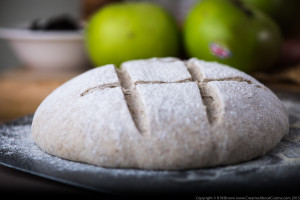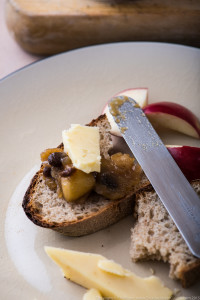 At its most simple, bread is just flour, yeast and water. Salt to enhance the flavour I would class as essential but it really needs no other additions. That having been said, the scope is endless and, for me at least, so is the pleasure. Baking bread was part of the daily rhythm of running a restaurant. Back in the early days when I was first in and working on my own a fair bit, it was my first job of the day – well, after switching on the coffee machine, of course!
At its most simple, bread is just flour, yeast and water. Salt to enhance the flavour I would class as essential but it really needs no other additions. That having been said, the scope is endless and, for me at least, so is the pleasure. Baking bread was part of the daily rhythm of running a restaurant. Back in the early days when I was first in and working on my own a fair bit, it was my first job of the day – well, after switching on the coffee machine, of course!
Weigh out the flour and salt, melt some butter to add a little richness, mix fresh yeast with a little of the weighed blood-temperature water and then get on with filleting the fish. Get the dough mixing and move on to the meat prep. Now, a coffee while the dough is proving. Shape according to my mood and get on with some other jobs. Around thirty minutes later in summer and an hour later in winter the bread is ready for the oven.
Wholemeal soda, sea salt focaccia, milk rolls, light rye, dark rye, granary, viennese, treacle rolls, ciabatta or Brioche; I enjoy making them all.
As time moved on, I personally made and baked the bread less often but it was still a part of the daily cycle and I got as much pleasure watching new chefs master the art of baking in a small kitchen as I do from baking myself. I still bake bread fairly regularly at home, weaving the process into the rest of my work for the day – the reward is huge. The smell, sound and taste of a freshly baked loaf is hard to beat. Flour is the real hero of good bread, that and a nice slow prove, perhaps with a starter made the day before. I use a baking stone in the oven with an old tray underneath to pour water onto to create some steam, but many new ovens have a steam function. An AEG oven I used recently at the Plumbase showroom launch in Bridport even had a 40℃ dough-proving setting. Just brilliant!
Give the recipe below a try or have a look at some more of my bread recipes on the Great British Chefs website
LIGHT RYE BREAD
STARTER
- 50g bread flour
- 25g rye flour
- 3g dried active yeast
- 75g water
- 15g milk or buttermilk
In a small bowl mix the flours together, weigh the yeast into a cup and mix in a couple of tablespoons of the water. Leave to dissolve for 10 minutes. Add the yeast mix and remaining liquids to the flour and mix well. Wrap the bowl with clingfilm and refrigerate for 24 hours. Allow to come to room temperature for 30 minutes before using.
DOUGH
Preheat the oven to 225℃
- 5g yeast
- 150g water
- 75g milk
- 300g bread flour
- 100g rye flour
- 12g fine ground Maldon salt
- 25g olive oil
Weigh out the yeast into a cup. Mix the water and milk and warm to around 37℃, then add a little to the yeast and allow to dissolve. Scrape the starter into the bowl of a stand mixer and add the yeast and then the flours. Add the salt and remaining liquid and mix on a slow speed for 12 minutes. Scrape the dough down from the dough hook and mix for another 5 minutes.
 Cover the bowl with clingfilm and allow to prove until doubled in size. Shape as your mood takes you, cover with oiled clingfilm and then a tea towel. Again, allow to prove until approximately doubled in size. I use a heavily floured linen cloth in a bread basket to prove the loaf. Tip the loaf out onto a peel covered in semolina and slide onto the baking stone in the preheated oven. A stiff piece of card or a flat oven sheet will serve as a peel if necessary. Tip half a cup of water into that old tray in the bottom of the oven and then repeat after 5 minutes. Bake for a further 5 minutes and then turn the oven down to 180℃ and cook for approximately 15 minutes.
Cover the bowl with clingfilm and allow to prove until doubled in size. Shape as your mood takes you, cover with oiled clingfilm and then a tea towel. Again, allow to prove until approximately doubled in size. I use a heavily floured linen cloth in a bread basket to prove the loaf. Tip the loaf out onto a peel covered in semolina and slide onto the baking stone in the preheated oven. A stiff piece of card or a flat oven sheet will serve as a peel if necessary. Tip half a cup of water into that old tray in the bottom of the oven and then repeat after 5 minutes. Bake for a further 5 minutes and then turn the oven down to 180℃ and cook for approximately 15 minutes.
A dark crust and a hollow sound when the bottom of the loaf is tapped shows the loaf is done. Allow to cool on a wire rack for 30 minutes before slicing, if you have the will power! I rarely do.


